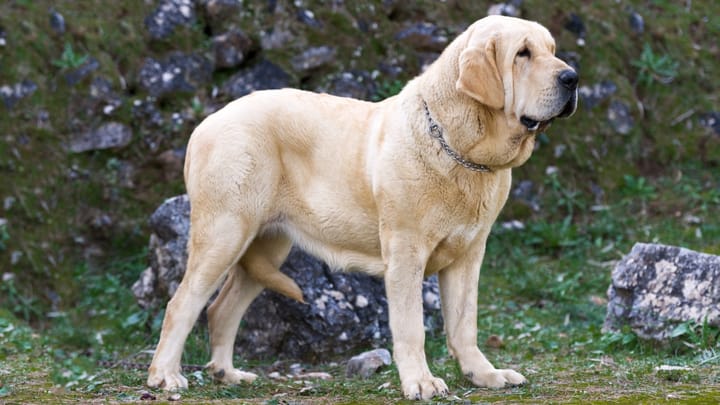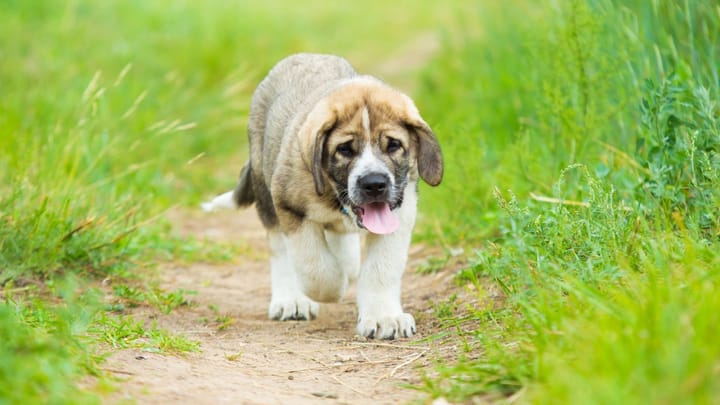Spanish Mastiff
Other names : Spanish Mastin, Leon’s Shepherd Dog, Channel Shepherd Dog, Extremadura Shepherd Dog


The Spanish Mastiff is a giant dog, mainly used as a guard dog. Calm and balanced, they prove to be formidable when their master, or whoever is accompanying them, is in danger. The problems encountered, during the redevelopment of the breed, have had a predominant impact on the character of this dog: some subjects are too aggressive, others (the majority) too shy. Selective breeding will undoubtedly eliminate these problems because the Spanish Mastiff is now well monitored and well brought up in their country of origin.
|
Life expectancy |
The Spanish Mastiff has a life expectancy of between 10 and 12 years |
|
Temperament |
|
|
Size |
Large
|
|
Adult size |
Female
Between 28 and 30 in
Male
Between 30 and 31 in
|
|
Adult weight |
Female
Between 132 and 198 lb
Male
Between 132 and 198 lb
|
|
Coat colour
All coat colours are acknowledged but the most widespread are yellow, fawn, red or black or even brindle or magpie tones. |
Black White Brown Blue Red Sand |
|
Type of coat
The coat is semi-long. The coat is thick, hard to the touch and soft. A protective coat is present on the sides and flanks. |
Long Hard |
|
Eye colour
They are a hazelnut colour, tending towards dark. |
Brown
|
|
Purchase price |
The Spanish Mastiff costs between £655 and £1125 |
This dog has the unique feature of elastic skin. One can easily spot the folds under their throat which allow them to be better protected from the bites of their enemies, who were mainly bears and wolves at the time.
More details about the Spanish Mastiff
Spanish Mastiff: Origins and history
The Spanish Mastiff is a very old dog that descends, like all Molosser types, from the Molosser of Tibet who arrived in Europe through Asia Minor. It is believed that the Spanish Mastiff was first used by Spanish shepherds 4,000 years ago and is considered to be the oldest breed in the country. The nature and climate of Spain have always forced shepherds to practice transhumance, i.e. to move their herds to areas of pasture that are sometimes very far away. For centuries, the Spanish Mastiff has been the protector of livestock, especially merino sheep, whose history is closely linked to that of this dog. In modern times, with the gradual disappearance of shepherd activity, the breed almost died out. The breed has now been rebuilt but with many difficulties and a good homogeneity of the type has not yet been found.
Physical characteristics of the Spanish Mastiff
The Spanish Mastiff is a well-proportioned, large and heavy dog, mesomorphic, with a compact skeleton. The head is large: the ratio between the skull and the muzzle is 6/4. The skull and muzzle, seen from above, is square and uniform. The skull and face axes are slightly divergent. The eyes are small in relation to the skull, almond-shaped. The ears are of medium size, triangular, flat and hanging. The legs are straight, strong and muscular. The tail is very large at the base, medium height, strong and flexible. It goes down to the hocks.
FCI classification of the Spanish Mastiff
-
Group 2 - Pinscher and Schnauzer - Molossoid and Swiss Mountain and Cattledogs
-
Section 2 : Molossian type
Spanish Mastiff: Characteristics
Spanish Mastiff: Behaviour
Training a Spanish Mastiff
When they are puppies, the Spanish Mastin, as they are called in their country of origin, must adopt the rules of life and educational principles to integrate as well as possible within their families and, more generally, within society.
Sometimes stubborn, it is not always easy to motivate them, but a good relationship between a master and his dog always achieves good results.
For cooperation to be effective, no brutality must come into play in the education of this soft-hearted colossus. Even if they are imposing, it is the gentle methods that allow them to become the balanced dog they deserve to be.
In consideration of their size, it is primarily the basic orders as well as socialisation that must be prioritised to maintain control over them, in any situation.
Spanish Mastiff: Lifestyle
Breed compatibility Spanish Mastiff
Spanish Mastiff: Purchase price
The price of a Spanish Mastiff varies according to their origin, age and gender. One would be looking at £1125 on average for a dog registered with the KC.
Concerning the average budget to support a dog of this size, one should allocate around £75/month.
Spanish Mastiff: Shedding
Average
Spanish Mastiffs lose their hair to a moderate extent, this loss is intensified during moulting periods when brushing must become more frequent.
Spanish Mastiff: Grooming
This dog does not require any grooming except brushing a few times per week, especially if they live indoors.
Their drooping ears need regular care to avoid infections.
Spanish Mastiff: Health
Life expectancy of Spanish Mastiffs is around 11 years.
They are rather delicate puppies but once grown, they are rustic and robust dogs.
Given their origin, this dog is well accustomed to high temperatures, so they are not afraid of heat.
Although they are robustly built and can, in theory, live outdoors, they can suffer from the cold despite their dense and thick coat. It is advisable to have them sleep in a warm place.
If they are not sufficiently exerted and their daily portions are too rich: beware of excessive weight gain.
- Hip dysplasia
- Stomach upset
- Ear infections
- Leishmaniasis (parasitic disease)




